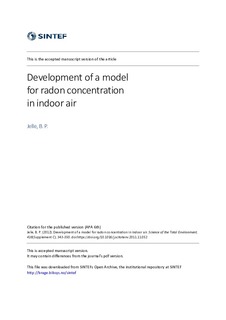| dc.contributor.author | Jelle, Bjørn Petter | |
| dc.date.accessioned | 2017-10-31T09:25:38Z | |
| dc.date.available | 2017-10-31T09:25:38Z | |
| dc.date.created | 2011-12-16T21:34:35Z | |
| dc.date.issued | 2012 | |
| dc.identifier.citation | Science of the Total Environment. 2012, 416 (1), 343-350. | nb_NO |
| dc.identifier.issn | 0048-9697 | |
| dc.identifier.uri | http://hdl.handle.net/11250/2463095 | |
| dc.description.abstract | A model is developed for calculation of the radon concentration in indoor air. The model takes into account various important parameters, e.g. radon concentration in ground, radon diffusion resistance of radon barrier, air permeance of ground, air pressure difference between outdoor ground and indoor at ground level, ventilation of the building ground and number of air changes per hour due to ventilation. Characteristic case studies are depicted in selected 2D and 3D graphical plots for easy visualization and interpretation. The radon transport into buildings might be dominated by diffusion, pressure driven flow or a mixture of both depending on the actual values of the various parameters. The results of our work indicate that with realistic or typical values of the parameters, most of the transport of radon from the building ground to the indoor air is due to air leakage driven by pressure differences through the construction. By incorporation of various and realistic values in the radon model, valuable information about the miscellaneous parameters influencing the indoor radon level is gained. Hence, the presented radon model may be utilized as a simple yet versatile and powerful tool for examining which preventive or remedial measures should be carried out to achieve an indoor radon level below the reference level as set by the authorities. | nb_NO |
| dc.language.iso | eng | nb_NO |
| dc.publisher | Elsevier B.V. | nb_NO |
| dc.rights | Attribution-NonCommercial-NoDerivatives 4.0 Internasjonal | * |
| dc.rights.uri | http://creativecommons.org/licenses/by-nc-nd/4.0/deed.no | * |
| dc.subject | Radon | nb_NO |
| dc.subject | Radon resistance | nb_NO |
| dc.subject | Radon diffusion | nb_NO |
| dc.subject | Air leakage | nb_NO |
| dc.subject | Modeling | nb_NO |
| dc.subject | Indoor air | nb_NO |
| dc.title | Development of a Model for Radon Concentration in Indoor Air | nb_NO |
| dc.type | Journal article | nb_NO |
| dc.type | Peer reviewed | nb_NO |
| dc.description.version | acceptedVersion | nb_NO |
| dc.rights.holder | © 2011 Elsevier B.V. All rights reserved. This is the authors' accepted and refereed manuscript to the article, post-print. Released with a Creative Commons Attribution Non-Commercial No Derivatives License. The final publication is available at https://doi.org/10.1016/j.scitotenv.2011.11.052 | nb_NO |
| dc.subject.nsi | VDP::Technology: 500 | nb_NO |
| dc.source.pagenumber | 343-350 | nb_NO |
| dc.source.volume | 416 | nb_NO |
| dc.source.journal | Science of the Total Environment | nb_NO |
| dc.source.issue | 1 | nb_NO |
| dc.identifier.doi | 10.1016/j.scitotenv.2011.11.052 | |
| dc.identifier.cristin | 869601 | |
| cristin.unitcode | 7401,30,40,0 | |
| cristin.unitname | Arkitektur, byggematerialer og konstruksjoner | |
| cristin.ispublished | true | |
| cristin.fulltext | original | |
| cristin.qualitycode | 2 | |


